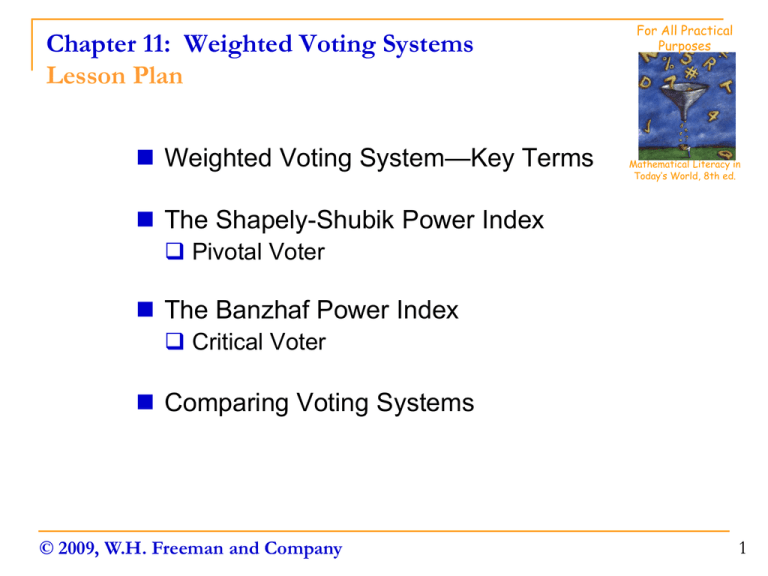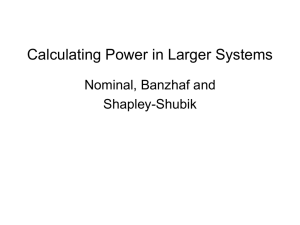Weighted Voting Systems
advertisement

Chapter 11: Weighted Voting Systems
Lesson Plan
Weighted Voting System—Key Terms
The Shapely-Shubik Power Index
Pivotal Voter
The Banzhaf Power Index
Critical Voter
Comparing Voting Systems
© 2009, W.H. Freeman and Company
For All Practical
Purposes
Mathematical Literacy in
Today’s World, 8th ed.
Chapter 11: Weighted Voting Systems
Weighted Voting Systems—Key Terms
Voting is often used to decide “yes” or “no” questions.
Weighted voting system – A voting system in which each
participant (voter) is assigned a voting weight. Different
participants may have different number of votes or voting weights.
There are three pieces of information we need:
1. How many votes each voter has.
The individual voter i has weight
wi . .
2. How many voters there are.
There are n voters. The sum of
their weights is w1 + w2 + …+ wn.
3. How many votes it takes to
approve an issue. The quota q is
the minimum number of votes to
pass.
Chapter 11: Weighted Voting Systems
Weighted Voting Systems—Key Terms
Shorthand notation:
[ q : w 1, w 2, … , w n ]
Quota: q is the minimum number of votes
needed to pass a measure.
If the sum of each voter’s weight who favors
a motion is equal to or greater than the
quota, then “yes” wins. Otherwise, “no” wins.
The quota must be at least a majority (to
avoid ties) and less than or equal to the sum
of all the weights.
½ (w1 + w2 + … + wn) < q w1 + w2 + … + wn
Weights of the voters: w1, w2, … , wn is the
number of votes assigned to each separate
voter in a weighted voting system. The variable
n represents how many voters in the system.
Notation for Weighted
Voting Systems – To
describe a weighted
voting system, you
must specify the
voting weights w1,
w2, ... ,wn of the
participants and the
quota q. The
following notation is
a shorthand way of
making these
specifications:
[ q : w1, w2, …, wn ]
Chapter 11: Weighted Voting Systems
Weighted Voting Systems—Key Terms
Electoral College
The United States elects the
president using the electoral
college, which is a weighted
voting system in which the
voters are the states.
The number of electors allotted
to a state is equal to the size of
its congressional delegation.
Congressional delegation = 1 elector per representative
and 2 electors (for the 2 senators)
Example: A state with 25 representatives would get 27 electors,
(25 representatives + 2 senators)
The weights range from 1 for individual congressional districts to
55, and the quota, 270, is a simple majority.
2000 presidential election: George W. Bush won with 271 electoral votes.
Chapter 11: Weighted Voting Systems
Weighted Voting Systems—Key Terms
Dictator – A voter with all the power. A voter can pass a motion by
voting “yes” even if all others vote “no.”
Dictator’s weight is greater than or equal to the quota.
Example: [51: 60, 40 ], the voter with 60 shares is a dictator.
Dummy – A voter whose votes do not count. Basically, a dummy’s
vote is never needed to pass or defeat any measure.
If there is a dictator, the rest of the voters are dummies.
Example: [8: 5,3,1], the voter with 1 vote is not needed to pass or block
any measure.
Veto Power – When one person has the power to defeat or block
a measure by himself. A voter whose vote is necessary to pass any
motion has veto power.
Example: [6: 5, 3, 1], the voter with 5 votes has veto power.
Power Index – We will look at two ways to measure the share of
power that each participant in a voting system has:
Shapely-Shubik Power Index and Banzhaf Power Index
Chapter 11: Weighted Voting Systems
The Shapely-Shubik Power Index
The Shapely-Shubik Power
Index (developed 1954)
The Shapley-Shubik power
index of each voter is
computed by counting the
number of permutations in
which he or she is pivotal and
then dividing it by the total
Lloyd S. Shapley
Martin Shubik
number of permutations.
Permutation – A permutation of voters is an ordering of all the
voters in a voting system.
Pivotal Voter – The first voter in a permutation who, when
joined by those coming before him or her, would have enough
voting weight to win is the pivotal voter in the permutation.
Each permutation has exactly one pivotal voter.
Factorial – For a positive whole number n
n! = n × (n − 1) × (n − 2) × … × 2 × 1 (where 0! = 1)
Chapter 11: Weighted Voting Systems
The Shapely-Shubik Power Index
Steps to Calculate the Shapely-Shubik Power Index
Step 1: Name the participants A, B, C, etc. (corresponding to the voters).
Step 2: For n voters, you will have n! permutations. Make a table listing the
voters’ permutations—list all ways to order the voters using letters.
Step 3: In the table to the right of each permutation, list the weight of the
first voter in the first column. Then in the second column, list the weight
of the first voter added to the weight of the second voter for each row.
In the third column, add the weights for the first three voters in that
permutation. Continue filling out the cumulative weights going across.
Step 4: Find the pivotal voter:
The first cumulative weight that is equal to or greater than the quota is
underlined in each row.
Then, the corresponding voter is circled in the permutation (same
column number in the permutation as the column of the underlined
weight).
Step 5: Count how many times each voter was pivotal out of the n! times.
List the Shapely-Shubik index of the voters as fractions. (The fraction
shows what proportion of power, or influence, each voter has.)
Chapter 11: Weighted Voting Systems
The Shapely-Shubik Power Index
Example: Find Shapely-Shubik power index for [6: 5, 3, 1]
Step 1:
A B C
Name the voters with letters
[6: 5, 3, 1]
corresponding to each weight.
Step 2: For n = 3 voters, there will be 3! = 3 × 2 × 1 = 6 permutations (n!).
Make a table listing all the 6 possible arrangements of 3 letters.
Step 3: List the cumulative weights of the voters for each permutation.
Step 4: Find the pivotal voter, underline
the cumulative weight that is equal
to or greater than the quota, and
circle the corresponding voter.
Step 5: Find the fraction of times each
voter was pivotal. A was pivotal 4
times out of 6. B and C were
pivotal 1 time out of 6.
Shapely-Shubik power index
for A, B, C is: (4/6, 1/6, 1/6).
Permutations and Pivotal Voters
Permutations
Weights
A
B
C
5
8
9
A
C
B
5
6
9
B
A
C
3
8
9
B
C
A
3
4
9
C
A
B
1
6
9
C
B
A
1
4
9
Chapter 11: Weighted Voting Systems
The Shapely-Shubik Power Index
How to Find Shapely-Shubik for Larger Voting Systems
For voting systems with more than four voters, listing all the
permutations will be very cumbersome. When n becomes very
large (n = 100), then n! becomes almost impossible to list.
If all the voters have the same voting weight, a list of all the
permutations is not needed because each voter would have the
same share of power.
Example: If there are n = 100 voters, each with 1 vote, the
Shapely-Shubik power index of each is 1/100.
Even if all but one or two have equal power, the Shapely-Shubik
power index can still be found without listing all permutations.
Two principles used in this method:
1. Voters with the same voting weight have the same Shapely-Shubik
power index.
2. The sum of the Shapley-Shubik power indices of all the voters is 1.
List the permutations by grouping them by the position occupied
by the chairperson (or co-chairs) and compute his (their) index,
then divide up the remaining share of power among the rest.
Chapter 11: Weighted Voting Systems
The Banzhaf Power Index
The Banzhaf Power Index
The Banzhaf power index is the number of
distinct winning or blocking coalitions in which
one’s vote is critical.
Coalition – A set of voters who are prepared to
vote for, or to oppose, a motion.
Winning coalition – The coalition that has
enough votes to pass the measure. The voters’
weights in the winning coalition must add up to John F. Banzhaf III
be equal to or greater than the quota q.
Sum of weights of winning coalition q
Blocking Coalition – Opposes a measure and has the votes to defeat
it. The voters’ weights in the blocking coalition must add up to more
than the total weight of all the voters minus the quota (ntotal − q).
Sum of weights of blocking coalition ntotal − q + 1
Losing Coalition – The coalition that does not have enough votes to
get its way.
Chapter 11: Weighted Voting Systems
The Banzhaf Power Index
Critical Voter
A member of a winning coalition whose vote is essential for the
coalition to win.
A member of a blocking coalition whose vote is essential for the
coalition to block.
Extra-Votes Principle
A winning coalition with a total weight w has w − q extra votes.
A blocking coalition with votes of total weight w has:
w − (n − q + 1) extra votes
(where n is the total weight of all the voters in the system)
The critical voters are those whose weight is more than the
coalition’s extra votes. These are the voters that the coalition
cannot afford to lose.
If extra votes = 0 ( which means the coalition’s weight = quota),
then all the members of that coalition are critical.
Chapter 11: Weighted Voting Systems
The Banzhaf Power Index
Steps to Calculate the Banzhaf Power Index
Step 1: List all the winning coalitions in the first column of the table.
Winning/Blocking Duality – The number of winning coalitions in
which a given voter is critical is equal to the number of blocking
coalitions in which the same voter is critical.
As a result, you can simply double the critical voter results of
the winning coalitions. Otherwise, a second table is needed
to make a list of the blocking coalitions.
Step 2: In the second column, list the total weight of all the voters in
that particular coalition in that row.
Step 3: In the third column, calculate the extra votes for the coalition.
Extra votes for the winning coalition is its weight minus the
quota. Extra votes = w – q.
Step 4: For the last n columns (n the number of voters), use the extravotes principle to identify the critical voters in each coalition.
Chapter 11: Weighted Voting Systems
The Banzhaf Power Index
Example: Find the Banzhaf power index for [3: 2, 1, 1]
Step 1: List all the winning coalitions in the first column of the table.
The winning coalitions would be the teams formed equal to or
greater than the quota (q = 3 or more) {A,B}, {A,C}, {A,B,C}.
Step 2: In the second column, list the total weight of all the voters in that
particular coalition in that row: {A,B} = 3, {A,C} = 3, {A,B,C} = 4.
Step 3: In the third column, calculate the extra votes. Subtract the quota,
q = 3 from the weight of each coalition. {A,B,C} = 4 − 3 = 1 extra vote.
Step 4: For the last three
columns, use the extra-votes
Winning
Extra Critical Votes
principle to identify the critical
Coalition Weight Votes A
B C
voters in each coalition.
{A, B}
3
0
1
1
0
Double the number of critical
{A, C}
3
0
1
0
1
voters for each participant to
{A, B, C}
4
1
1
0
0
find the Banzhaf power index
1
1
Totals 3
for A, B, C: (6, 2, 2).
A has 3 times as much power as B or C!
Chapter 11: Weighted Voting Systems
The Banzhaf Power Index
Voting Combinations – A record of how the voters cast
their votes for or against a given proposition.
Voting “yes” or “no” can be compared to a binary system of binary
digits or bits, which can be 0 or 1.
There is a total of 2n combination in an n-element set.
Using the combination formula below, there aren C k voting
combinations, with k “yes” votes and n − k “no” votes.
Combination Formula
Given a set of n objects, or voters, the combination formula helps
to calculate how many ways you can choose k number of objects.
n!
Calculate
40!
40 × 39 × 38 × 37 × 36!
=
=
C4
Ck =
40
k! (n − k)!
4! (40 − 4)!
4 × 3 × 2 × 1 × 36!
n
= 91,390
Chapter 11: Weighted Voting Systems
Comparing Voting Systems
Comparing Voting Systems – In many cases, different weighted
voting systems results in having the same winning coalitions.
Equivalent Voting Systems – Two voting systems are equivalent
if there is a way for all of the voters of the first system to exchange
places with the voters of the second system and preserve all winning
coalitions. Example: [50: 49, 1] and [4: 3, 3] are equivalent because each
require unanimous support to pass a measure.
Minimal
Winning
Coalition A winning
coalition in
which each
voter is a
critical voter.
Voting Systems with Three Participants
System
Minimal Winning Coalition
Weights
Banzhaf Index
Dictator
{A}
[ 3: 3, 1, 1 ]
( 8, 0, 0 )
Clique
{A, B}
[ 4: 2, 2, 1 ]
( 4, 4, 0 )
Majority
{A, B}, {A, C}, {B, C}
[ 2: 1, 1, 1 ]
( 4, 4, 4 )
Chair Veto
{A, B}, {A, C}
[ 3: 2, 1, 1 ]
( 6, 2, 2)
Consensus
{A, B, C}
[ 3: 1, 1, 1 ]
( 2, 2, 2 )








